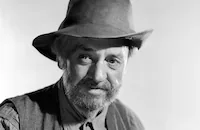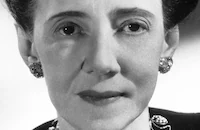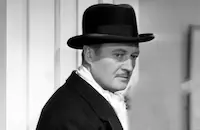Intruder in the Dust

Brief Synopsis
Cast & Crew
Clarence Brown
David Brian
Claude Jarman Jr.
Juano Hernandez
Porter Hall
Elizabeth Patterson
Film Details
Technical Specs

Synopsis
A short time after Vinson Gowrie, a white lumberman, is found murdered in a small town, Lucas Beauchamp, a black landowner, is arrested and charged with the killing. As Lucas is led by Sheriff Hampton through an angry crowd of people gathered at the jail house, he turns to Chick Mallison, a white youth he has befriended, and asks him to summon John Gavin Stevens, Chick's lawyer uncle, to his aid. Recalling the November day he first met Lucas, Chick later tells John the story of how he and the black man became friends: While on a rabbit-hunting expedition with his black friend Aleck, Chick falls into an icy river and nearly drowns, but is rescued by Lucas, who owns the land around the river. Lucas takes Chick to his home and gives him food and dry clothes, but Chick, who has not been taught to respect black people, does not know how to react to his generosity. One day, at Fraser's General Store, Chick witnesses a group of white men taunting Lucas, and sees Vinson attempt to strike Lucas on the head. While Chick watches in motionless silence, some of the men surround Vinson and prevent him from completing the assault. Chick concludes his story by telling John that, despite his silence, Lucas considers him to be his friend and has placed his trust in him. John reluctantly agrees to take the case, and when he and Chick visit Lucas in his jail cell, Lucas tells them that he was beaten by a white lumberman, who forced him to identify his business partner, Vinson, as the man who was stealing lumber from him. Lucas is cautious and refuses to tell John any more details about the incident, but he privately asks Chick to dig up Vinson's body to prove that the bullet that killed Vinson was not fired from his gun. Although John opposes Chick's plan to exhume Vinson's body, Chick later finds an ally in Miss Eunice Habersham, an elderly woman who believes that Chick may be on the trail of an important clue. Late one night, Miss Habersham, Aleck and Chick go to the chapel at which Vinson is supposed to have been buried and begin digging up the grave. When they open the coffin, however, they are surprised to discover that it is empty. The discovery of the missing corpse convinces John and the sheriff that Lucas is innocent, and they join Chick in his search for Vinson's body. With help from Nub Gowrie, Vinson's father, John, the sheriff and others follow a trail of footprints that lead to a patch of quicksand near a river. Vinson's body is retrieved from the quicksand, after which it is determined that the bullet that killed him could not have been fired from Lucas' gun. Back in town, an angry crowd of white men, led by Vinson's brother Crawford, surrounds the jail house and demands that Lucas be lynched. Meanwhile, inside the jail house, Lucas tells John and Chick that although he was present when Vinson was shot and can identify Vinson's business partner, he never saw the man who fired the gun. Concluding that Vinson's business partner must be the killer, and that he is trying to frame Lucas for the murder, the sheriff and John decide to set a trap for the killer. After announcing that Lucas has been released from jail, the sheriff waits for the killer to try to silence Lucas. The plan works, and the killer is revealed to be Crawford. Crawford is arrested, and as he is led into the jail house, the townspeople gathered outside the jail house disperse.

Director

Clarence Brown
Cast

David Brian

Claude Jarman Jr.

Juano Hernandez

Porter Hall

Elizabeth Patterson

Charles Kemper

Will Geer
David Clarke
Elzie Emanuel
Lela Bliss
Harry Hayden
Harry Antrim

Dan White
Alberta Dishmon
R. S. Williams
Julia S. Marshbanks
Ephraim Lowe

Edmund Lowe
Jack Odom
Freddie B. Patton
W. P. Haley
Dr. Allison Busby
Harold Gean
John M. Keel
W. G. Kimmons
Robert Lee Young
C. E. Slough
Jack Bronfeld
Noel Hodge
George T. Hemphill
Dewey Mccoy
Eugene Roper
John Morgan

James Kirkwood
Joyce Ann Baron
Eylla Jacobus
Mrs. E. P. Lowe
Guy Turnbowe
Ben J. Hilbun
E. H. Windham
George Winter
John E. Avent
Will Lewis
E. P. Lowe
Homer Arnold
E. L. Hooker
Tommy Bond
Ann Hartsfield
Howard Winters
Crew
Clarence Brown
Clarence Brown
Jack Dawn
Adolph Deutsch
Randall Duell
Cedric Gibbons
Jerome Hester
Albert Hunter
Ralph S. Hurst
Eylla Jacobus
Robert J. Kern
Ben Maddow
Jay Marchant
John Schmitz
Douglas Shearer
Marvin Stuart
Robert Surtees
Edwin B. Willis

Photo Collections
Videos
Movie Clip


Trailer
Film Details
Technical Specs

Articles
Intruder in the Dust
The driving force behind Intruder in the Dust was Clarence Brown, who had been one of MGM's top directors since the mid-1920s. In the 1930s, he had become acquainted with Faulkner, who worked briefly as a screenwriter at MGM. Although born in Massachusetts, Brown had grown up in Tennessee, and considered himself a Southerner. As a teenager, he had witnessed the bloody 1906 race riots in Atlanta, and had never forgotten them. Brown was an admirer of Faulkner's books, and when he read Intruder in the Dust before it was published, it resonated for him. He asked MGM studio head Louis B. Mayer to buy it. Mayer was convinced it would be a failure and refused. But when the liberal producer Dore Schary, who had made several "message" pictures, took over as head of production at MGM in 1948, he persuaded Mayer to approve the project. MGM bought the rights for $50,000, to the delight of the perennially cash-strapped Faulkner.
To play Chick, Brown chose Claude Jarman, Jr., whom he had discovered and cast in The Yearling (1946) when Jarman was a 12 year-old Nashville schoolboy. Following the success of that film, Jarman moved to Hollywood and attended the MGM studio school. His performance in Intruder in the Dust was one of his best, and one of his personal favorites.
Intruder in the Dust was also a milestone in the film career of Juano Hernandez. A black man of Puerto Rican and Brazilian parentage, he had been a boxer, a vaudevillian, a radio scriptwriter, and a radio and stage actor in New York. His first film role was as a drug lord in The Girl from Chicago (1932), directed by black independent producer Oscar Micheaux. After several small parts in Micheaux films, Intruder in the Dust was Hernandez's first film for a major Hollywood studio, and the beginning of a distinguished mainstream film career. The film earned him a Golden Globe nomination as "Most Promising Newcomer" in 1950.
MGM agreed to Brown's request to shoot much of Intruder in the Dust on location in Faulkner's home town of Oxford, Mississippi, provided that lodging could be found for a company of 100 people. The University of Mississippi agreed to house and feed the white cast and crew, but what about the black actors? The Chamber of Commerce said lodgings would be provided "in the homes of Oxford's colored leaders." Juano Hernandez would stay at the home of a prominent black undertaker.
Some members of the community objected to the story, and Faulkner helped to smooth things over with them. He also helped find locations, and discussed the script with Brown, but because he was under contract to Warner Bros., he could not contribute to it. However, according to Faulkner's biographer Joseph Blotner, he approved most of the scenes, made suggestions for changes to others, and revised the last scene "considerably in an effort to make it less sentimental." Faulkner even coached Hernandez in the local dialect, feeling that Hernandez's "clear and precise enunciation made him sound like a Shakespearean" rather than a Mississippi black man. (from Faulkner: A Biography by Joseph Blotner)
Oxford enthusiastically embraced the film company. Many of the townsfolk appeared as extras in Intruder in the Dust, and even those who didn't turned out at the Lyric Theatre every night to join the film crew watching dailies. The film had its world premiere at the Lyric in October of 1949, with Jarman riding one of Faulkner's own horses in a parade. Although Faulkner hated the hoopla surrounding the premiere, and attended only grudgingly, he liked the final film. "I don't know much about movies, but I thought it was one of the best I've ever seen," he said. "Mr. Brown knows his medium, and he's made a fine picture. I wish I had made it." And proving that he had the observational abilities to make a fine movie critic, Faulkner added, "I like the way Mr. Brown used bird calls and saddle squeaks and footsteps in place of a lot of loud music telling you what emotion you should be experiencing."
As Mayer had predicted, Intruder in the Dust was a box-office failure. Although the film was a critical success, 1949 audiences were not ready for a nuanced portrayal of a complex and unapologetic black man. Dore Schary writes in his autobiography, "I predicted it would be viewed in years to come as one of our best. We were both proven right."
In his essay about the "problem pictures" of 1949, novelist Richard Wright wrote, "Intruder in the Dust is the only film that could be shown in Harlem without arousing unintended laughter. For it is the only one ...in which Negroes can make complete identification with their screen image. Interestingly, the factors that make this identification possible lie in its depiction not of racial but of human quality."
Producer/Director: Clarence Brown
Screenplay: Ben Maddow, William Faulkner (novel)
Cinematography: Robert Surtees
Film Editing: Robert Kern
Art Direction: Randall Duell, Cedric Gibbons
Music: Adolph Deutsch
Cast: David Brian (John Gavin Stevens), Claude Jarman, Jr. (Chick Mallison), Juano Hernandez (Lucas Beauchamp), Porter Hall (Nub Gowrie), Elizabeth Patterson (Eunice Habersham), Charles Kemper (Crawford Gowrie).
BW-88m.
by Margarita Landazuri

Intruder in the Dust
Quotes
Trivia
Notes
The working title of this film was The Intruder. A July 1948 Hollywood Reporter news item noted that M-G-M paid $50,000 for the film rights to William Faulkner's novel. A February 1949 Hollywood Reporter news item indicates that Joel McCrea was considered for the part played by David Brian. Although late March and early April 1949 Hollywood Reporter production charts list Albert Akst as the film editor, onscreen credits list Robert Kern.
Intruder in the Dust marked the first major screen appearance of former radio and stage actor Juano Hernandez (1901-1970). Previously, Hernandez had appeared in minor roles in three African-American films, beginning with The Girl from Chicago (1932, ) and ending with Lying Lips (1939, see below), both of which were directed by noted African-American director and producer Oscar Micheaux.
Intruder in the Dust was shot on location in Oxford, MS. As the town was segregated at the time of production, Hernandez was forced to live apart from the rest of the film's cast and crew. According to an April 1949 New York Times article, Hernandez stayed with a local African-American undertaker. According to a December 1949 Daily Variety news item, director Clarence Brown shot the picture without a sound track, and then dubbed the dialogue after the completion of camera work. Although the professional actors dubbed their own voices, Brown used radio actors' and extras' voices for those of the local Oxford people who appeared in the picture.

Miscellaneous Notes
Released in United States March 1975
Released in United States Winter February 3, 1950
Released in United States Winter February 3, 1950
Released in United States March 1975 (Shown at FILMEX: Los Angeles International Film Exposition March 13-26, 1975.)














